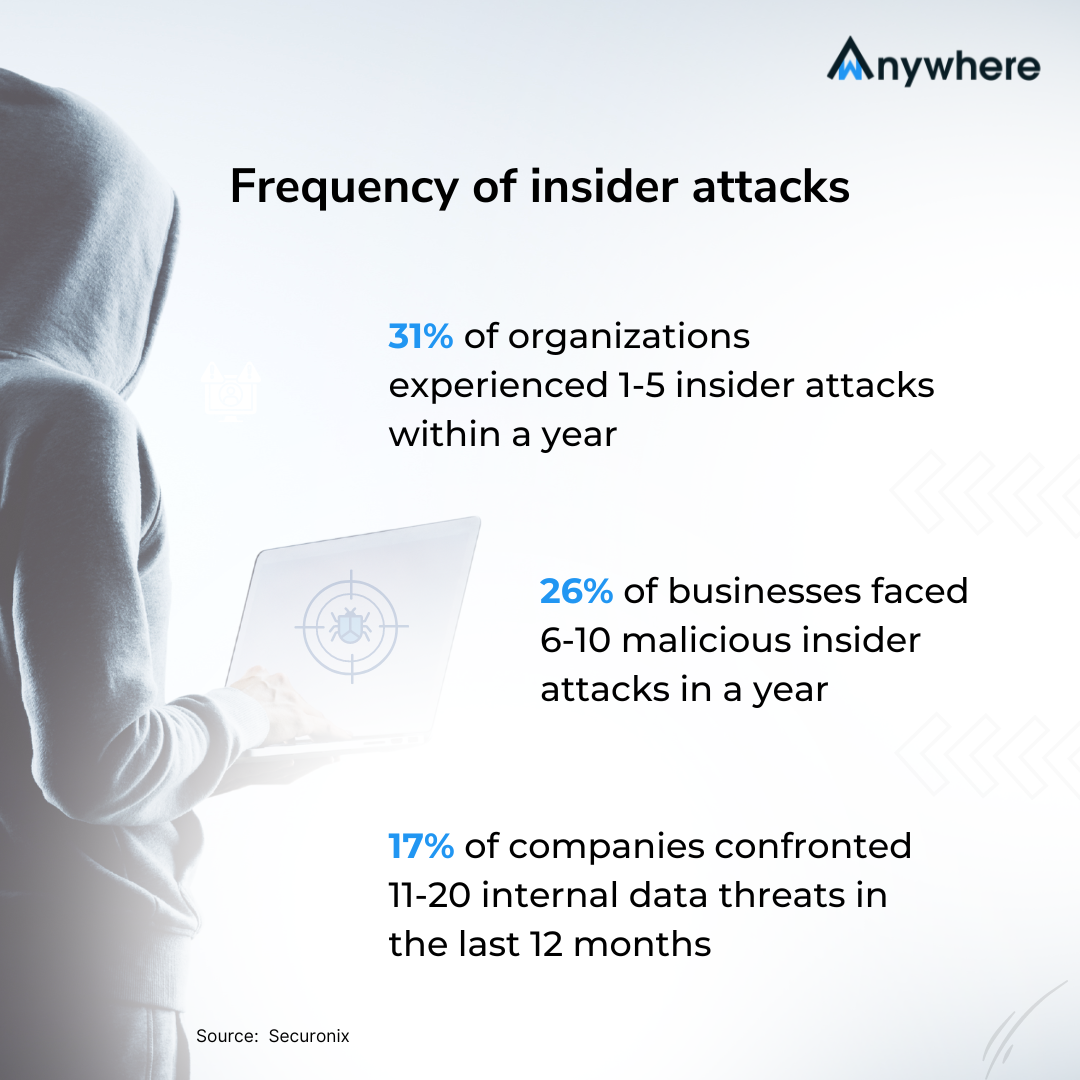In 2024, around 90% of organizations expressed concerns about growing internal data threats – among them 53% of organizations find it tricky to identify and curb data risks while 37% of organizations find internal data breaches more difficult to predict and prevent than external data attacks. The surge in unauthorized data exposure has almost doubled since 2019, indicating an urgent need to control malicious insiders and information security.
Table of Contents
Maintaining workplace compliance and operational efficiency is a challenge for industries, including BFSIs and BPOs where data privacy matters the most. Evolving workplaces and growing hybrid work have added to the complexities of aligning the distributed workforce with regulatory policies. A Securonix Insider Threat Report 2024 reveals that 70% of organizations with data critical operations express moderate concerns about insider risks in distributed and less controlled work environments – while 20% of them are specifically concerned and 18% are extremely concerned, the rest 32% are those aware of threats and looking for effective counter measures and risk prevention strategies.

Change in occurrence of insider attacks in the last 12 months
The Securonix report shows a significant increase in data risks within the organization, indicating an urgent need for data protection strategies to identify and curb threats.
Most frequent
The data shows about 40% of businesses experienced a considerable increase in the frequency of insider attacks in the last year, highlighting a dynamic threat landscape where internal risks are on the rise.
Stayed the same
The report further reveals that 35% of data-intensive businesses with effective security measures observed no data risks and a stable threat environment.
Less frequent
Meanwhile, 25% of companies perceived a reduction in threat frequency, potentially pointing to considerable improvements in their security posture.
What are the most concerned insider attack methods
The study adds that data attacks are more targeted toward making information public, breaching regulatory compliance, and hijacking critical business resources. These all indicate a high need for robust risk management to counter threats.
Information disclosure
Most insider threats in organizations lead to sensitive information disclosure, data mishandling, and clipboard data.
Credential and account abuse
The majority of internal data risks involve credential sharing, unauthorized data access, privilege escalation, and account manipulation.
Security evasion and bypass
Increasing data attacks including workarounds, policy violations, resource hijacking, and scheduled tasks for long-term access.
Which data is at the most risk of insider attacks
From financial records and customer data to employee details and personal health information (PHI), these are the highly sensitive resources that internal threats target the most.
Financial records
The report identifies that the financial data is the most vulnerable, with 44% of organizations expressing concerns about it, due to its potential for direct monetization.
Customer data
Further report details add that customer data, at 41%, closely follows, highlighting concerns about the breach of personally identifiable information (PII).
Employee details
Employee data is a high concern with 37% as the report shows, hinting at the awareness need for the risks posed by information mishandling.
Personal health information (PHI)
The threat report points out that a considerable 31% believe all sensitive organizational information is at risk, indicating a bigger concern for business data privacy.
High vulnerability of an organization to insider threats
In 2024, the combined percentage of organizations feeling vulnerable to threats was 66%, compared to 69% in 2019, signaling improved awareness yet a need for firm insider threat prevention.
Extremely vulnerable
The threat report indicates a significant rise in those experiencing extreme vulnerability from 5% in 2019 to 16% in 2024.
Very vulnerable
Among the organizations facing the most threats from insiders, 18% of them say they are highly susceptible to data risks.
Moderately vulnerable
32% of companies with information-intensive business processes are concerned about growing threats to data confidentiality.
Let’s understand the key factors behind the observed growth in insider attacks to help organizations strengthen their security posture and remediate the root causes.
Main drivers enabling an increase in insider attacks
The study underscores the absence of proper training and awareness as the prime cause of insider threats, with 37% of companies responding the same. It hints at the high need for a robust security program that helps in awareness, prediction, and prevention of internal data risks.
Lack of awareness
37% of organizations are concerned about insufficient employee training and lack of security awareness that can put data at risk with their uninformed behavior.
Inadequate security measures
29% of companies experience insufficient security measures for data loss protection and a lack of consistent policies that malicious insiders can exploit to cause harm.
Disgruntled insiders
25% of data-critical businesses face insider challenges from dissatisfied employees or contract teams with revengeful intent that can cause a threat to data privacy.
Best practices to mitigate data threats
Growing insider attacks indicate a serious internal threat environment and a vital need for organizations to strengthen security posture in financial services, banking, or BPO operations and firmly counter data breach instances.
Identify risky actions that need extra attention
You need to identify your sensitive data that can be personally identifiable information (PII), financial information, etc. and requires extra protection to avoid risk.
Control transfer of sensitive files
Have a policy that blocks the transfer of sensitive files and makes it harder for your most vital data to make it out of the organization.
Observe user behavior
Observe for risky behavior that could be indicative of a malicious insider. Have tools in place that monitor activities across multiple data points and then you can detect anomalies like someone trying to access or breach data that is not related to their role.
Monitor PII activities
Focus on the areas that need the most attention – like customer PII (personally identifiable information), and the crucial information your organization holds. Utilize tools to track activity when PII is accessed and set policies to control access or transfers of PII if policies are breached.
App and web monitoring
Observe applications like email accounts, chats, or any other method of communication that indicates the risk of data exfiltration to predict and prevent malicious insiders. Take a proactive approach to monitor web browsing and flag risky websites.
Safeguard your critical data and business operations
Organizations need to amplify their focus on insider threat detection and prevention strategies, investing in helpful resources like effective security and compliance software that can help counter increasing incident frequency. The growing data threats underline the urgent need for continuous monitoring and robust defense mechanisms. Leverage AI-powered advanced security and compliance capabilities of wAnywhere to protect your crucial data and critical business operations. Start a free trial today to experience how the monitoring tool can safeguard your business.
What is the security and compliance process and the role of wAnywhere monitoring?
Security and compliance management helps define rules to ensure regulations with industry standards. With continuous monitoring, wAnywhere helps implement and observe regulatory policies to control threats.
Why is security and compliance important?
The absence of security and compliance can risk a company with insider threats and data breaches. Enabling regulatory compliance and data privacy policies effectively helps safeguard your critical information and business operations.





